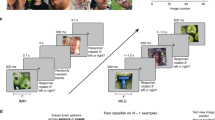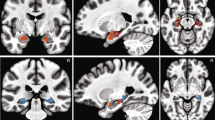Abstract
Here we used magnetoencephalography (MEG) to investigate stages of processing in face perception in humans. We found a face-selective MEG response occurring only 100 ms after stimulus onset (the 'M100'), 70 ms earlier than previously reported. Further, the amplitude of this M100 response was correlated with successful categorization of stimuli as faces, but not with successful recognition of individual faces, whereas the previously-described face-selective 'M170' response was correlated with both processes. These data suggest that face processing proceeds through two stages: an initial stage of face categorization, and a later stage at which the identity of the individual face is extracted.
This is a preview of subscription content, access via your institution
Access options
Subscribe to this journal
Receive 12 print issues and online access
$209.00 per year
only $17.42 per issue
Buy this article
- Purchase on Springer Link
- Instant access to full article PDF
Prices may be subject to local taxes which are calculated during checkout





Similar content being viewed by others
References
Rosch, E., Mervis, C.B., Gray, W.D., Johnson, D.M. & Boyes-Braem, P. Basic objects in natural categories. Cognit. Psychol. 8, 382–349 (1976).
Jolicoeur, P., Gluck, M.A. & Kosslyn, S.M. Pictures and names: making the connection. Cognit. Psychol. 16, 243–275 (1984).
Sugase, Y., Yamane, S., Ueno, S. & Kawano, K. Global and fine information coded by single neurons in the temporal visual cortex. Nature 400, 869–873 (1999).
Tanaka, J.W. & Taylor, M. Object categories and expertise: is the basic level in the eye of the beholder? Cognit. Psychol. 23, 457–482 (1991).
Tanaka, J.W. The entry point of face recognition: evidence for face expertise. J. Exp. Psychol. Gen. 130, 534–543 (2001).
Grill-Spector, K. & Kanwisher, N. Common cortical mechanisms for different components of visual object recognition: a combined behavioral and fMRI study. J. Vision 1, 474a (2001).
Bentin, S., Allison, T., Puce, A., Perez, E. & McCarthy, G. Electrophysiological studies of face perceptions in humans. J. Cogn. Neurosci. 8, 551–565 (1996).
Jeffreys, D.A. Evoked potential studies of face and object processing. Vis. Cogn. 3, 1–38 (1996).
Sams, M., Hietanen, J.K., Hari, R., Ilmoniemi, R.J. & Lounasmaa, O.V. Face-specific responses from the human inferior occipito-temporal cortex. Neuroscience 77, 49–55 (1997).
Liu, J., Higuchi, M., Marantz, A. & Kanwisher, N. The selectivity of the occipitotemporal M170 for faces. Neuroreport 11, 337–341 (2000).
Bruce, V. & Young, A. Understanding face recognition. Br. J. Psychol. 77 (Pt 3), 305–327 (1986).
Eimer, M. The face-specific N170 component reflects late stages in the structural encoding of faces. Neuroreport 11, 2319–2324 (2000).
Seeck, M. et al. Evidence for rapid face recognition from human scalp and intracranial electrodes. Neuroreport 8, 2749–2754 (1997).
Schendan, H.E., Ganis, G. & Kutas, M. Neurophysiological evidence for visual perceptual categorization of words and faces within 150 ms. Psychophysiology 35, 240–251 (1998).
Mouchetant-Rostaing, Y., Giard, M.H., Bentin, S., Aguera, P.E. & Pernier, J. Neurophysiological correlates of face gender processing in humans. Eur. J. Neurosci. 12, 303–310 (2000).
Kawasaki, H. et al. Single-neuron responses to emotional visual stimuli recorded in human ventral prefrontal cortex. Nat. Neurosci. 4, 15–16 (2001).
Braeutigam, S., Bailey, A.J. & Swithenby, S.J. Task-dependent early latency (30–60 ms) visual processing of human faces and other objects. Neuroreport 12, 1531–1536 (2001).
Streit, M., Wolwer, W., Brinkmeyer, J., Ihl, R. & Gaebel, W. Electrophysiological correlates of emotional and structural face processing in humans. Neurosci. Lett. 278, 13–16 (2000).
George, N., Jemel, B., Fiori, N. & Renault, B. Face and shape repetition effects in humans: a spatiotemporal ERP study. Neuroreport 8, 1417–1423 (1997).
VanRullen, R. & Thorpe, S.J. The time course of visual processing: from early perception to decision-making. J. Cogn. Neurosci. 13, 454–461 (2001).
Allison, T., Puce, A., Spencer, D.D. & McCarthy, G. Electrophysiological studies of human face perception. I: Potentials generated in occipitotemporal cortex by face and non-face stimuli. Cereb. Cortex 9, 415–430 (1999).
Tootell, R.B., Mendola, J.D., Hadjikhani, N.K., Liu, A.K. & Dale, A.M. The representation of the ipsilateral visual field in human cerebral cortex. Proc. Natl. Acad. Sci. USA 95, 818–824 (1998).
Sadr, J. & Sinha, P. Exploring object perception with Random Image Structure Evolution. MIT Artif. Int. Lab. Memo, 2001–6 (2001).
Sadr. J. & Sinha, P. Object recognition and random image structure evolution. Cognit. Sci. (in press).
Watson, A.B. & Pelli, D.G. Quest: a Bayesian adaptive psychometric method. Percept. Psychophys. 33, 113–120 (1983).
Thorpe, S., Fize, D. & Marlot, C. Speed of processing in the human visual system. Nature 381, 520–522 (1996).
Hämäläinen, M., Hari, R., Ilmoniemi, R.J., Knuutila, J. & Lounasmaa, O.V. Magnetoencephalography: theory, instrumentation and applications to noninvasive studies of the working human brain. Rev. Mod. Phys. 65, 413–497 (1993).
Bentin, S. in Encyclopedia of Cognitive Science (ed. Nadel, L.) Neural basis of face perception. (Macmillan, London, in press).
Oram, M.W. & Perrett, D.I. Time course of neural responses discriminating different views of the face and head. J. Neurophysiol. 68, 70–84 (1992).
Rolls, E.T. Neurons in the cortex of the temporal lobe and in the amygdala of the monkey with responses selective for faces. Hum. Neurobiol. 3, 209–222 (1984).
Thorpe, S.J. & Fabre-Thorpe, M. Seeking categories in the brain. Science 291, 260–263 (2001).
Gomez Gonzalez, C.M., Clark, V.P., Fan, S., Luck, S.J. & Hillyard, S.A. Sources of attention-sensitive visual event-related potentials. Brain Topogr. 7, 41–51 (1994).
Thorpe, S. & Imbert, M. Connectionism in Perspective (eds. Pfeifer, R., Schreter, Z., Fogelman-Soulie, F. & Steels, L.) 63–92 (Elsevier, Amsterdam, 1989).
Kovacs, G., Vogels, R. & Orban, G.A. Cortical correlate of pattern backward masking. Proc. Natl. Acad. Sci. USA 92, 5587–5591 (1995).
Keysers, C., Xiao, D.K., Foldiak, P. & Perrett, D.I. The speed of sight. J. Cogn. Neurosci. 13, 90–101 (2001).
Farah, M.J. Visual Cognition (eds. Kosslyn, S. M. & Osherson, D. N.) 101–119 (MIT Press, Cambridge, Massachusetts, 1995).
Rainer, G., Augath, M., Trinath, T. & Logothetis, N.K. Nonmonotonic noise tuning of BOLD fMRI signal to natural images in the visual cortex of the anesthetized monkey. Curr. Biol. 11, 846–854 (2001).
Acknowledgements
We thank J. Sadr and P. Sinha for helpful discussions on their RISE technique, M. Eimer, S. Hillyard, A. Marantz, M. Valdes-Sosa, P. Downing, W. Freiwald, K. Grill-Spector, Y. Jiang and the rest of the Kanwisher Lab for comments on the manuscript. Supported by the Reed Fund and National Eye Institute grant (EY13455) to N.K.
Author information
Authors and Affiliations
Corresponding author
Ethics declarations
Competing interests
The authors declare no competing financial interests.
Rights and permissions
About this article
Cite this article
Liu, J., Harris, A. & Kanwisher, N. Stages of processing in face perception: an MEG study. Nat Neurosci 5, 910–916 (2002). https://doi.org/10.1038/nn909
Received:
Accepted:
Published:
Issue Date:
DOI: https://doi.org/10.1038/nn909
This article is cited by
-
Early visual alterations in individuals at-risk of Alzheimer’s disease: a multidisciplinary approach
Alzheimer's Research & Therapy (2023)
-
Entering into a self-regulated learning mode prevents detrimental effects of feedback removal on memory
npj Science of Learning (2023)
-
Posterior theta activity reveals an early signal of self-face recognition
Scientific Reports (2023)
-
The dual neural effects of oxytocin in autistic youth: results from a randomized trial
Scientific Reports (2022)
-
Medial prefrontal and occipito-temporal activity at encoding determines enhanced recognition of threatening faces after 1.5 years
Brain Structure and Function (2022)



